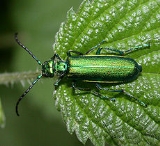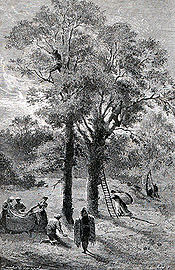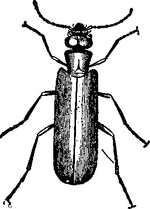
Spanish fly
Encyclopedia
The Spanish fly is an emerald-green beetle
in the family
Meloidae, Lytta vesicatoria. Other species of blister beetle
used by apothecaries
are often called by the same name. Lytta vesicatoria is sometimes incorrectly called Cantharis vesicatoria, but the genus Cantharis
is in an unrelated family, Cantharidae.
Cantharidin (etymology: Greek kantharis, beetle) is a powerful irritant vesicant (blister-inducing) substance obtained from many blister beetles, and sometimes given the nickname "Spanish fly." Cantharidin is claimed to have aphrodisiac
properties, as a result of its irritant effects upon the body's genitourinary tract, and can result in poisoning if ingested. Ingestion of blister beetles from infested hay causes similar serious toxic symptoms in animals.
, the principal irritant in Spanish fly, was first isolated and named in 1810 by Pierre Robiquet, a French chemist then living in Paris, from Lytta vesicatoria. Robiquet demonstrated that cantharidin was the actual principle responsible for the aggressively blistering properties of the coating of the eggs of that insect, and established that cantharidin had very definite toxic and poisonous properties comparable in degree to that of the most violent poisons known in the 19th century, such as strychnine
.
Cantharidin, a terpenoid
, is produced by various insect species. The body of the beetle contains up to 5% cantharidin. The crushed powder is of yellowish brown to brown-olive color with iridescent reflections, of disagreeable scent and bitter flavor.
. Plaster
s made from wings of these beetles have been used to raise blister
s. In ancient China, the beetles were mixed with human excrement, arsenic
and wolfsbane
to make the world's first recorded stink bomb
.
 Various preparations of desiccated Spanish flies have been used as some of the world's oldest alleged aphrodisiacs, with a reputation dating back to the early western mediterranean classical civilizations:
Various preparations of desiccated Spanish flies have been used as some of the world's oldest alleged aphrodisiacs, with a reputation dating back to the early western mediterranean classical civilizations:
, catharides are used in incense
.
Cantharide was used as an abortifacient
, a stimulant (since one of its effects was producing insomnia
and nervous agitation), and as a poison.
In order to determine if a death had taken place by the effects of Spanish fly, investigators resorted to the vesicación test. One of those test methods consisted of rubbing part of the internal organs of the deceased, dissolved in oil, on the shaved skin of a rabbit; the absorption of the cantharides and its blistering effect are such that they became visible on the skin of the rabbit.

s.
, almond paste
, pistachio nuts, sugar, orange or tamarind
peel, clove
s and other various spices, occasionally included cantharides.
In Morocco
and other parts of North Africa, a spice blend called Ras el hanout
included cantharides in its list of ingredients at one time. However, the sale of cantharides in Moroccan spice markets was banned in the 1990s.
Beetle
Coleoptera is an order of insects commonly called beetles. The word "coleoptera" is from the Greek , koleos, "sheath"; and , pteron, "wing", thus "sheathed wing". Coleoptera contains more species than any other order, constituting almost 25% of all known life-forms...
in the family
Family (biology)
In biological classification, family is* a taxonomic rank. Other well-known ranks are life, domain, kingdom, phylum, class, order, genus, and species, with family fitting between order and genus. As for the other well-known ranks, there is the option of an immediately lower rank, indicated by the...
Meloidae, Lytta vesicatoria. Other species of blister beetle
Blister beetle
Blister beetles are beetles of the family Meloidae, so called for their defensive secretion of a blistering agent, cantharidin. There are approximately 7,500 known species worldwide. Many are conspicuous and some aposematically colored, announcing their toxicity to would-be...
used by apothecaries
Apothecary
Apothecary is a historical name for a medical professional who formulates and dispenses materia medica to physicians, surgeons and patients — a role now served by a pharmacist and some caregivers....
are often called by the same name. Lytta vesicatoria is sometimes incorrectly called Cantharis vesicatoria, but the genus Cantharis
Cantharis
Cantharis is a large genus of soldier beetles in the family Cantharidae with narrow and soft elytra. The superficially similar poisonous spanish fly, sometimes called Cantharis vesicatoria or just Cantharis vernacularly, is actually unrelated to Cantharis. It is now named Lytta vesicatioria and...
is in an unrelated family, Cantharidae.
Cantharidin (etymology: Greek kantharis, beetle) is a powerful irritant vesicant (blister-inducing) substance obtained from many blister beetles, and sometimes given the nickname "Spanish fly." Cantharidin is claimed to have aphrodisiac
Aphrodisiac
An aphrodisiac is a substance that increases sexual desire. The name comes from Aphrodite, the Greek goddess of sexuality and love. Throughout history, many foods, drinks, and behaviors have had a reputation for making sex more attainable and/or pleasurable...
properties, as a result of its irritant effects upon the body's genitourinary tract, and can result in poisoning if ingested. Ingestion of blister beetles from infested hay causes similar serious toxic symptoms in animals.
The beetle
Lytta vesicatoria is 15 millimetre (0.590551181102362 in) to 22 millimetre (0.866141732283465 in) long and 5 millimetre (0.196850393700787 in) to 8 millimetre (0.31496062992126 in) wide. Adult beetles feed on leaves of ash, lilac, amur privet and white willow trees; larvae are parasitic on the brood of ground nesting bees. The beetle lives in scrublands and woods throughout southern Europe and eastward to Central Asia and Siberia.Cantharidin
CantharidinCantharidin
Cantharidin, a type of terpenoid, is a poisonous chemical compound secreted by many species of blister beetle, and most notably by the Spanish fly, Lytta vesicatoria. The false blister beetles and cardinal beetles also have cantharidin.-History:...
, the principal irritant in Spanish fly, was first isolated and named in 1810 by Pierre Robiquet, a French chemist then living in Paris, from Lytta vesicatoria. Robiquet demonstrated that cantharidin was the actual principle responsible for the aggressively blistering properties of the coating of the eggs of that insect, and established that cantharidin had very definite toxic and poisonous properties comparable in degree to that of the most violent poisons known in the 19th century, such as strychnine
Strychnine
Strychnine is a highly toxic , colorless crystalline alkaloid used as a pesticide, particularly for killing small vertebrates such as birds and rodents. Strychnine causes muscular convulsions and eventually death through asphyxia or sheer exhaustion...
.
Cantharidin, a terpenoid
Terpenoid
The terpenoids , sometimes called isoprenoids, are a large and diverse class of naturally occurring organic chemicals similar to terpenes, derived from five-carbon isoprene units assembled and modified in thousands of ways. Most are multicyclic structures that differ from one another not only in...
, is produced by various insect species. The body of the beetle contains up to 5% cantharidin. The crushed powder is of yellowish brown to brown-olive color with iridescent reflections, of disagreeable scent and bitter flavor.
Early uses
Medical use dates back to descriptions from HippocratesHippocrates
Hippocrates of Cos or Hippokrates of Kos was an ancient Greek physician of the Age of Pericles , and is considered one of the most outstanding figures in the history of medicine...
. Plaster
Plaster
Plaster is a building material used for coating walls and ceilings. Plaster starts as a dry powder similar to mortar or cement and like those materials it is mixed with water to form a paste which liberates heat and then hardens. Unlike mortar and cement, plaster remains quite soft after setting,...
s made from wings of these beetles have been used to raise blister
Blister
A blister is a small pocket of fluid within the upper layers of the skin, typically caused by forceful rubbing , burning, freezing, chemical exposure or infection. Most blisters are filled with a clear fluid called serum or plasma...
s. In ancient China, the beetles were mixed with human excrement, arsenic
Arsenic
Arsenic is a chemical element with the symbol As, atomic number 33 and relative atomic mass 74.92. Arsenic occurs in many minerals, usually in conjunction with sulfur and metals, and also as a pure elemental crystal. It was first documented by Albertus Magnus in 1250.Arsenic is a metalloid...
and wolfsbane
Aconitum
Aconitum , known as aconite, monkshood, wolfsbane, leopard's bane, women's bane, Devil's helmet or blue rocket, is a genus of over 250 species of flowering plants belonging to the buttercup family .-Overview:These herbaceous perennial plants are chiefly natives of the mountainous parts of the...
to make the world's first recorded stink bomb
Stink bomb
A stink bomb or stinkbomb is a device designed to create an unpleasant smell. They range in effectiveness from simple pranks to military grade or riot control chemical agents.The Guinness Book of Records lists two smelliest substances...
.
Aphrodisiac

- In RomanRoman EmpireThe Roman Empire was the post-Republican period of the ancient Roman civilization, characterised by an autocratic form of government and large territorial holdings in Europe and around the Mediterranean....
times, LiviaLiviaLivia Drusilla, , after her formal adoption into the Julian family in AD 14 also known as Julia Augusta, was a Roman empress as the third wife of the Emperor Augustus and his adviser...
, the scheming wife of Augustus Caesar, slipped it into food hoping to inspire her guests to some indiscretion with which she could later blackmail them. - Henry IVHenry IV, Holy Roman EmperorHenry IV was King of the Romans from 1056 and Holy Roman Emperor from 1084 until his forced abdication in 1105. He was the third emperor of the Salian dynasty and one of the most powerful and important figures of the 11th century...
(1050–1106) is known to have consumed Spanish fly at the risk of his health. - In 1572, Ambroise ParéAmbroise ParéAmbroise Paré was a French surgeon. He was the great official royal surgeon for kings Henry II, Francis II, Charles IX and Henry III and is considered as one of the fathers of surgery and modern forensic pathology. He was a leader in surgical techniques and battlefield medicine, especially the...
wrote an account of a man suffering from "the most frightful satyriasisHypersexualityHypersexuality is extremely frequent or suddenly increased sexual urges or sexual activity. Hypersexuality is typically associated with lowered sexual inhibitions. Although hypersexuality can be caused by some medical conditions or medications, in most cases the cause is unknown...
" after taking a potion composed of nettleNettleNettles constitute between 24 and 39 species of flowering plants of the genus Urtica in the family Urticaceae, with a cosmopolitan though mainly temperate distribution. They are mostly herbaceous perennial plants, but some are annual and a few are shrubby...
s and cantharides. - In the 1670s, Spanish fly was mixed with dried moles and bat's blood for a love charm made by the magician La Voisin.
- It was slipped into the food of Louis XIV to secure the king's lust for Madame de Montespan.
- In the 18th century, cantharides became fashionable, known as pastilles Richelieu in France.
- The Marquis de SadeMarquis de SadeDonatien Alphonse François, Marquis de Sade was a French aristocrat, revolutionary politician, philosopher, and writer famous for his libertine sexuality and lifestyle...
is claimed to have given aniseed-flavored pastilles that were laced with Spanish fly to prostitutes at an orgy in 1772. He was sentenced to death for poisoning and sodomy, but later reprieved on appeal.
Miscellaneous uses
In medicine, cantharidin is used as a topical application for treatment of benign epithelial growths including most warts. In SanteríaSantería
Santería is a syncretic religion of West African and Caribbean origin influenced by Roman Catholic Christianity, also known as Regla de Ocha, La Regla Lucumi, or Lukumi. Its liturgical language, a dialect of Yoruba, is also known as Lucumi....
, catharides are used in incense
Incense
Incense is composed of aromatic biotic materials, which release fragrant smoke when burned. The term "incense" refers to the substance itself, rather than to the odor that it produces. It is used in religious ceremonies, ritual purification, aromatherapy, meditation, for creating a mood, and for...
.
Cantharide was used as an abortifacient
Abortifacient
An abortifacient is a substance that induces abortion. Abortifacients for animals that have mated undesirably are known as mismating shots....
, a stimulant (since one of its effects was producing insomnia
Insomnia
Insomnia is most often defined by an individual's report of sleeping difficulties. While the term is sometimes used in sleep literature to describe a disorder demonstrated by polysomnographic evidence of disturbed sleep, insomnia is often defined as a positive response to either of two questions:...
and nervous agitation), and as a poison.
Poison
In powder, mixed with the food, cantharide could go unnoticed. Aqua toffana, or aquetta di Napoli, was one of the poisons associated with the Medicis. Thought to be a mixture of arsenic and cantharides, it was reportedly created by an Italian countess, Toffana. Four to six drops of this poison in water or wine was enough to deliver death in a few hours.In order to determine if a death had taken place by the effects of Spanish fly, investigators resorted to the vesicación test. One of those test methods consisted of rubbing part of the internal organs of the deceased, dissolved in oil, on the shaved skin of a rabbit; the absorption of the cantharides and its blistering effect are such that they became visible on the skin of the rabbit.

Commercial products
Use of cantharides is illegal in most countries, except by licensed physicians for the topical treatment of certain types of wartWart
A wart is generally a small, rough growth, typically on a human’s hands or feet but often other locations, that can resemble a cauliflower or a solid blister. They are caused by a viral infection, specifically by human papillomavirus 2 and 7. There are as many as 10 varieties of warts, the most...
s.
Culinary use
Dawamesk, a spread or jam made in North Africa and containing hashishHashish
Hashish is a cannabis preparation composed of compressed stalked resin glands, called trichomes, collected from the unfertilized buds of the cannabis plant. It contains the same active ingredients but in higher concentrations than unsifted buds or leaves...
, almond paste
Almond meal
Almond meal, almond flour or ground almond is made from ground sweet almonds. Almond flour is usually made with blanched almonds , whereas almond meal can be made both with whole or blanched almonds...
, pistachio nuts, sugar, orange or tamarind
Tamarind
Tamarind is a tree in the family Fabaceae. The genus Tamarindus is monotypic .-Origin:...
peel, clove
Clove
Cloves are the aromatic dried flower buds of a tree in the family Myrtaceae. Cloves are native to the Maluku islands in Indonesia and used as a spice in cuisines all over the world...
s and other various spices, occasionally included cantharides.
In Morocco
Morocco
Morocco , officially the Kingdom of Morocco , is a country located in North Africa. It has a population of more than 32 million and an area of 710,850 km², and also primarily administers the disputed region of the Western Sahara...
and other parts of North Africa, a spice blend called Ras el hanout
Ras el hanout
Ras el hanout or Rass el hanout is a popular Moroccan blend of spices that is used across North Africa. The name means "top of the shop" in Arabic and refers to a mixture of the best spices a seller has to offer...
included cantharides in its list of ingredients at one time. However, the sale of cantharides in Moroccan spice markets was banned in the 1990s.

